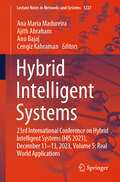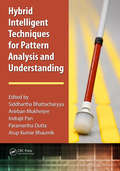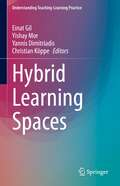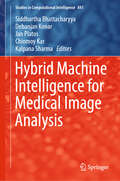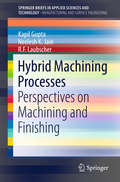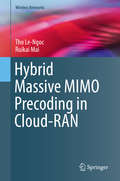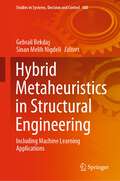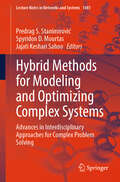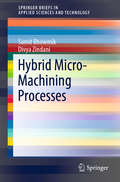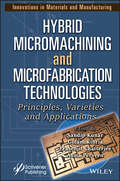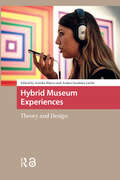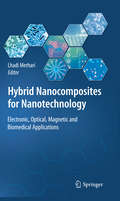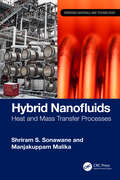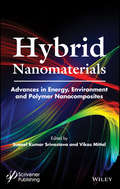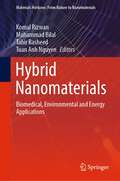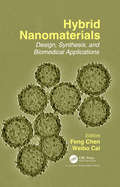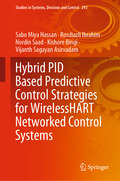- Table View
- List View
Hybrid Intelligent Systems: 23rd International Conference on Hybrid Intelligent Systems (HIS 2023), December 11-13, 2023, Volume 5: Real World Applications (Lecture Notes in Networks and Systems #1227)
by Ajith Abraham Cengiz Kahraman Ana Maria Madureira Anu BajajThis book presents 48 selected papers focused on Real World Applications from the 23rd International Conference on Hybrid Intelligent Systems, which was held in five different cities namely Olten, Switzerland; Porto, Portugal; Kaunas, Lithuania; Greater Noida, India; Kochi, India and in online mode. The 23rd International Conference on Hybrid Intelligent Systems (HIS 2023) was focusing on synergistic combinations of multiple approaches to develop the next generation of intelligent systems. HIS 2023 had contributions by authors from 44 countries. This book offers a valuable reference guide for all specialists, scientists, academicians, researchers, students, and practitioners in the field of artificial intelligence and real-world applications.
Hybrid Intelligent Techniques for Pattern Analysis and Understanding
by Siddhartha Bhattacharyya Paramartha Dutta Anirban Mukherjee Indrajit Pan Arup Kumar BhaumikHybrid Intelligent Techniques for Pattern Analysis and Understanding outlines the latest research on the development and application of synergistic approaches to pattern analysis in real-world scenarios. An invaluable resource for lecturers, researchers, and graduates students in computer science and engineering, this book covers a diverse range of hybrid intelligent techniques, including image segmentation, character recognition, human behavioral analysis, hyperspectral data processing, and medical image analysis.
Hybrid Intelligent Technologies in Energy Demand Forecasting
by Wei-Chiang HongThis book is written for researchers and postgraduates who are interested in developing high-accurate energy demand forecasting models that outperform traditional models by hybridizing intelligent technologies. It covers meta-heuristic algorithms, chaotic mapping mechanism, quantum computing mechanism, recurrent mechanisms, phase space reconstruction, and recurrence plot theory. The book clearly illustrates how these intelligent technologies could be hybridized with those traditional forecasting models. This book provides many figures to deonstrate how these hybrid intelligent technologies are being applied to exceed the limitations of existing models.
Hybrid L1 Adaptive Control: Applications of Fuzzy Modeling, Stochastic Optimization and Metaheuristics (Studies in Systems, Decision and Control #422)
by Gautam Sarkar Roshni Maiti Kaushik Das SharmaThis book details the designing of hybrid control strategies for practical systems containing time varying uncertainties, disturbances, nonlinearities, unknown parameters, unmodelled dynamics, delays, etc., concurrently. In this book, the advantages of different controllers will be brought together to produce superior control performance for the practical systems. Being aware of the advantages of adaptive controller to tackle unknown constant, time varying uncertainties and time varying disturbances, a variant of adaptive controller, namely L1 adaptive controller, is hybridized with other strategies. In this book, to facilitate optimal parameter setting of the basic L1 adaptive controller, stochastic optimization technique will be hybridized with it. The stability of the optimization technique along with the controller will be guaranteed analytically with the help of spectral radius convergence. The proposed method exhibits satisfactory exploration and exploitation capabilities. Again, this book will throw light on tackling nonlinearities along with uncertainties and disturbances by hybridizing fuzzy logic with L1 adaptive controller. The performances of the designed controllers will be compared with different control methodologies to validate their effectiveness. The overall stability of the nonlinear system with the designed controller will be guaranteed with the help of fuzzy Lyapunov function to retain the zonal behaviour of the system. This fuzzy PDC-L1 adaptive controller is efficient to tackle nonlinearities and at the same time cancels unknown constant, time varying uncertainties and time varying disturbances adequately. This book will also contain four simulation case studies to validate fruitfulness of the designed controllers. To demonstrate the superior control ability of these controllers in tackling practical system, three experimental case studies will also be provided.
Hybrid Latex Particles
by Alex M. Herk Katharina LandfesterHistorical Overview of (Mini)emulsion Polymerizations and Preparation of Hybrid Latex Particles, by A.M. van Herk; * Physical Methods for the Preparation of Hybrid Nanocomposite Polymer Latex Particles, by R. F.A. Teixeira and S. A.F. Bon; * Organic/Inorganic Composite Latexes: The Marriage of Emulsion Polymerization and Inorganic Chemistry, by Elodie Bourgeat-Lami and Muriel Lansalot; * Preparation of Hybrid Latex Particles and Core-Shell Particles Through the Use of Controlled Radical Polymerization Techniques in Aqueous Media, by Bernadette Charleux, Franck D'Agosto, and Guillaume Delaittre; * Miniemulsion Polymerization as a Means to Encapsulate Organic and Inorganic Materials, by Clemens K.Weiss and Katharina Landfester; * Organic-Inorganic Hybrid Magnetic Latex, by Md Mahbubor Rahman and Abdelhamid Elaissari
Hybrid Learning Spaces (Understanding Teaching-Learning Practice)
by Yishay Mor Einat Gil Yannis Dimitriadis Christian KöppeAs we have come to accept the duality of physical and virtual learning spaces as a permanent feature of our educational landscape, we begin to question its validity. Is this really a dichotomy, or is it a continuum? Should this be the primary dimension around which we cluster educational experiences - how does it intersect and interact with other axes, such as formal-informal, vocational-recreational, open-closed, teacher-student? How do we adapt, as teachers, learners, designers, policy makers, to this changing landscape? How do we shape it to offer an optimal learning experience? Such questions led us to conduct a series of academic and professional events on the theme of Hybrid Learning Spaces (HLS) - spaces which challenge and defy the dichotomies above. This edited book collates some of the products of that endeavor, offering a multi-vocal, interdisciplinary approach to hybridity in education. It connects practical examples, design directives and theoretical analysis, combining perspectives from technology research and development, educational theory and practice, architecture and space and product design. This book addresses researchers, practitioners, innovators and policy makers in education, technology and design, offering broad perspectives and then distilling practical insights in the form of design principles and patterns, pedagogical models, and predictions of future trends.
Hybrid Machine Intelligence for Medical Image Analysis (Studies in Computational Intelligence #841)
by Kalpana Sharma Siddhartha Bhattacharyya Debanjan Konar Jan Platos Chinmoy KarThe book discusses the impact of machine learning and computational intelligent algorithms on medical image data processing, and introduces the latest trends in machine learning technologies and computational intelligence for intelligent medical image analysis. The topics covered include automated region of interest detection of magnetic resonance images based on center of gravity; brain tumor detection through low-level features detection; automatic MRI image segmentation for brain tumor detection using the multi-level sigmoid activation function; and computer-aided detection of mammographic lesions using convolutional neural networks.
Hybrid Machining Processes
by Kapil Gupta Neelesh K. Jain R. F. LaubscherThis book describes various hybrid machining and finishing processes. It gives a critical review of the past work based on them as well as the current trends and research directions. For each hybrid machining process presented, the authors list the method of material removal, machining system, process variables and applications. This book provides a deep understanding of the need, application and mechanism of hybrid machining processes.
Hybrid Manufacturing Processes: Physical Fundamentals, Modelling and Rational Applications (Springer Series in Advanced Manufacturing)
by Wit Grzesik Adam RuszajThis book explores, in a systematic way, both conventional and unconventional material shaping processes with various modes of hybridization in relation to theory, modelling and industrial potential. The demand for high productivity and high accuracy in manufacturing is continuously increasing, based on improvement and optimization strategies. Hybridization of manufacturing processes will play a crucial role and will be of a key importance in achieving environmental and economical sustainability.Structured in three parts, Hybrid Manufacturing Processes summarizes the state-of-the art hybrid manufacturing processes based on available literature sources and production reports. The book begins by providing information on the physical fundamentals of the removal and non-removal processes in macro-, micro and nanoscales. It then follows with an overview of the possible ways of hybridization and the effects on the enhancement of process performance, before concluding with a summary of production outputs related to surface integrity, specifically with respect to difficult-to-machine materials.Considering the applications of different sources of hybridization including mechanical, thermal and chemical interactions or their combinations, this book will be of interest to a range of researchers and practicing engineers within the field of manufacturing.
Hybrid Massive MIMO Precoding in Cloud-RAN (Wireless Networks)
by Tho Le-Ngoc Ruikai MaiThis book covers the design and optimization of hybrid RF-baseband precoding for massive multiple-input multiple-output (MIMO)-enabled cloud radio access networks (RANs), where use cases such as millimeter-wave wireless backhauling, fully-loaded cellular networks are of interest. The suitability and practical implementation of the proposed precoding solutions for the Cloud RAN architecture are also discussed.Novel techniques are examined for RF precoding optimization in combination with nonlinear precoding at baseband, and the superiority of joint RF-baseband design is verified. Moreover, the efficacy of hybrid RF-baseband precoding to combat intercell interference in a multi-cell environment with universal frequency reuse is investigated, which is concluded to be a promising enabler for the dense deployment of base stations. This book mainly targets researchers and engineers interested in the challenges, optimization, and implementation of massive MIMO precoding in 5G Cloud RAN. Graduate students in electrical engineering and computer science interested in the application of mathematical optimization to model and solve precoding problems in massive MIMO cellular systems will also be interested in this book.
Hybrid Metaheuristics in Structural Engineering: Including Machine Learning Applications (Studies in Systems, Decision and Control #480)
by Gebrail Bekdaş Sinan Melih NigdeliFrom the start of life, people used their brains to make something better in design in ordinary works. Due to that, metaheuristics are essential to living things, and several inspirations from life have been used in the generation of new algorithms. These algorithms have unique features, but the usage of different features of different algorithms may give more effective optimum results in means of precision in optimum results, computational effort, and convergence. This book is a timely book to summarize the latest developments in the optimization of structural engineering systems covering all classical approaches and new trends including hybrids metaheuristic algorithms. Also, artificial intelligence and machine learning methods are included to predict optimum results by skipping long optimization processes. The main objective of this book is to introduce the fundamentals and current development of methods and their applications in structural engineering.
Hybrid Metal Additive Manufacturing: Technology and Applications (Advances in Manufacturing, Design and Computational Intelligence Techniques)
by Kishor Kumar Gajrani Parnika Shrivastava Anil DhanolaThe text presents the latest research and development, technical challenges, and future directions in the field of hybrid metal additive manufacturing. It further discusses the modeling of hybrid additive manufacturing processes for metals, hybrid additive manufacturing of composite materials, and low-carbon hybrid additive manufacturing processes. THIS BOOK •Presents cutting-edge advancements and limitations in hybrid additive manufacturing technologies. • Discusses fabrication methods and rapid tooling techniques focusing on metals, composites, and alloys. •Highlights the importance of low-carbon additive manufacturing technologies toward achieving sustainability. •Emphasizes the challenges and solutions for integrating additive manufacturing and Industry 4.0 to enable rapid manufacturing of customized and tailored products. • Covers hybrid additive manufacturing of composite materials and additive manufacturing for fabricating high-hardness components. The text discusses the recent advancements in additive manufacturing of high-hardness components and covers important engineering materials such as metals, alloys, and composites. It further highlights defects and post-processing of hybrid additive manufacturing components, sustainability solutions for hybrid additive manufacturing processes, and recycling o
Hybrid Methods for Modeling and Optimizing Complex Systems: Advances in Interdisciplinary Approaches for Complex Problem Solving (Lecture Notes in Networks and Systems #1481)
by Predrag S. Stanimirović Spyridon D. Mourtas Jajati Keshari SahooDelivering innovative methods for addressing complex systems, this book presents the latest advances in hybrid modeling, machine learning, and digital technologies. Based on selected papers from the III International Workshop &“Hybrid Methods of Modeling and Optimization in Complex Systems&” held December 2–4, 2024, in Krasnoyarsk, Russia, the book covers hybrid modeling and optimization, intelligent data analysis, financial forecasting, industrial and educational digitalization, AI-guided decision support, and digital system security. Readers will find such interdisciplinary applications as climate project modeling, agricultural digital services, and the digital platform economy; e-learning analysis and digital competence development; digital twins and production optimization; as well as research on network systems. It is essential for researchers, practitioners, and educators seeking practical solutions and advanced hybrid methods for diverse scientific and engineering challenges.
Hybrid Micro-Machining Processes (SpringerBriefs in Applied Sciences and Technology)
by Divya Zindani Sumit BhowmikThis book presents some of the recent hybrid micro-machining processes used to manufacture miniaturized products with micro level precision. The current developed technologies to manufacture the micro dimensioned products while meeting the desired precision level are described within the text. The authors especially highlight research that focuses on the development of new micro machining platforms while integrating the different technologies to manufacture the micro components in a high throughput and cost effective manner.
Hybrid Micromachining and Microfabrication Technologies: Principles, Varieties and Applications (Innovations in Materials and Manufacturing)
by Golam Kibria Prasenjit Chatterjee Sandip Kunar Asma PerveenHYBRID MICROMACHINING and MICROFABRICATION TECHNOLOGIES The book aims to provide a thorough understanding of numerous advanced hybrid micromachining and microfabrication techniques as well as future directions, providing researchers and engineers who work in hybrid micromachining with a much-appreciated orientation. The book is dedicated to advanced hybrid micromachining and microfabrication technologies by detailing principals, techniques, processes, conditions, research advances, research challenges, and opportunities for various types of advanced hybrid micromachining and microfabrication. It discusses the mechanisms of material removal supported by experimental validation. Constructional features of hybrid micromachining setup suitable for industrial micromachining applications are explained. Separate chapters are devoted to different advanced hybrid micromachining and microfabrication to design and development of micro-tools, which is one of the most vital components in advanced hybrid micromachining, and which can also be used for various micro and nano applications. Power supply, and other major factors which influence advanced hybrid micromachining processes, are covered and research findings concerning the improvement of machining accuracy and efficiency are reported.
Hybrid Modeling and Optimization of Manufacturing
by J. Paulo Davim Omar López-Armas Ramón QuizaArtificial intelligence (AI) techniques and the finite element method (FEM) are both powerful computing tools, which are extensively used for modeling and optimizing manufacturing processes. The combination of these tools has resulted in a new flexible and robust approach as several recent studies have shown. This book aims to review the work already done in this field as well as to expose the new possibilities and foreseen trends. The book is expected to be useful for postgraduate students and researchers, working in the area of modeling and optimization of manufacturing processes.
Hybrid Museum Experiences: Theory and Design (MediaMatters)
by Annika Waern Anders Sundnes LøvlieSo you're the one getting this gift? Lucky you! Someone who knows you has visited the museum. They searched out things they thought you would care about, and they took photos and left messages for you., This is the welcoming message for the Gift app, designed to create a very personal museum visit. Hybrid Museum Experiences use new technologies to augment, expand or alter the physical experience of visiting the museum. They are designed to be experienced in close relation to the physical space and exhibit. In this book we discuss three forms of hybridity in museum experiences: Incorporating the digital and the physical, creating social, yet personal and intimate experiences, and exploring ways to balance visitor participation and museum curation. This book reports on a 3-year cross-disciplinary research project in which artists, design researchers and museum professionals have collaborated to create technology-mediated experiences that merge with the museum environment.
Hybrid Nanocomposites for Nanotechnology
by Lhadi MerhariThis book covers the latest advances in polymer-inorganic nanocomposites, with particular focus on high-added-value applications in fields including electronics, optics, magnetism and biotechnology. The unique focus of this book is on electronic, optical, magnetic and biomedical applications of hybrid nanocomposites. Coverage includes: Synthesis methods and issues and production scale-up; Characterization methods; Electronic applications; Optical applications and Photonics; Magnetic applications; and Biomedical applications. The book offers readers a solid grasp of the state of the art, and of current challenges in non-traditional applications of hybrid nanocomposites.
Hybrid Nanofluids: Heat and Mass Transfer Processes (Emerging Materials and Technologies)
by Shriram S. Sonawane Manjakuppam MalikaThis book provides a comprehensive understanding of advanced hybrid nanofluid applications in various fields while also explaining the real-time industrial applications of nanofluids. It explains mathematical, numerical, and experimental methodologies of application of the nanofluids in heat transfer and mass transfer processes. It helps build innovative nanofluid-based devices, including the study and measurement of thermophysical characteristics, convection, and heat transfer equipment performance.Features: Discusses hybrid nanofluids with a strong attention to the processes. Explores inter-relation between thermal properties, physical properties, and optical properties of the nanofluids. Investigates high-performance heat transfer and mass transfer hybrid nanofluids. Explores data for the design of the nanofluid application and scale-up challenges. Reviews industrial operation and scale-up challenges for nanofluid applications in the industrial process. This book is aimed at graduate students and researchers in fluid dynamics, nanotechnology, and chemical and mechanical engineering.
Hybrid Nanomaterials: Advances in Energy, Environment, and Polymer Nanocomposites
by Vikas Mittal Suneel Kumar SrivastavaA hybrid material is defined as a material composed of an intimate mixture of inorganic components, organic components, or both types of components. In the last few years, a tremendous amount of attention has been given towards the development of materials for efficient energy harvesting; nanostructured hybrid materials have also been gaining significant advances to provide pollutant free drinking water, sensing of environmental pollutants, energy storage and conservation. Separately, intensive work on high performing polymer nanocomposites for applications in the automotive, aerospace and construction industries has been carried out, but the aggregation of many fillers, such as clay, LDH, CNT, graphene, represented a major barrier in their development. Only very recently has this problem been overcome by fabrication and applications of 3D hybrid nanomaterials as nanofillers in a variety of polymers. This book, Hybrid Nanomaterials, examines all the recent developments in the research and specially covers the following subjects: Hybrid nanostructured materials for development of advanced lithium batteries High performing hybrid nanomaterials for supercapacitor applications Nanohybrid materials in the development of solar energy applications Application of hybrid nanomaterials in water purification Advanced nanostructured materials in electromagnetic shielding of radiations Preparation, properties and application of hybrid nanomaterials in sensing of environmental pollutants Development of hybrid fillers/polymer nanocomposites for electronic applications High performance hybrid filler reinforced epoxy nanocomposites State-of-the-art overview of elastomer/hybrid filler nanocomposites
Hybrid Nanomaterials: Biomedical, Environmental and Energy Applications (Materials Horizons: From Nature to Nanomaterials)
by Tuan Anh Nguyen Tahir Rasheed Muhammad Bilal Komal RizwanThis book elaborates on the fabrication of organic-inorganic hybrid nanomaterials, their advantages, self-assembly and their applications in diverse fields of energy, biotechnology, biomedical and environment. The contents provide insight into tools, tricks and challenges associated with techniques of fabrication and future challenges and risks. This book also discusses the properties of modern hybrid nanomaterials and their performance, durability, reproducibility and sensitivity. It will be useful for students and researchers in the area of nanotechnology, science, engineering and environmental chemistry. This volume will also be useful for researchers and professionals working on nanohybrid materials.
Hybrid Nanomaterials: Design, Synthesis, and Biomedical Applications
by Feng Chen Weibo CaiOver the last decade, an unprecedented expansion in the field of nanomedicine has resulted in the development of new nanomaterials for diagnosis and therapy of various diseases such as cancer. This book covers the design, synthesis and applications of various functionally-hybridized nanomaterials for biomedical applications. It includes strategies for design and synthesis of hybrid nanomaterials, surface engineering of various nanoparticle-based hybrid nanosystems for cancer imaging and therapy, toxicity aspects of nanomaterials and the challenges in translation research of hybrid nanomaterials.
Hybrid Nanostructures as Solid-State Sensors for IoT
by Arindam Biswas Aniruddha MondalThe book provides an in-depth discussion of various Hybrid Nanostructures as solid-state sensors in the context of the Internet of Things (IoT). It explains the vital role that sensors play in IoT to aid in discovering what possibilities ought to be addressed to make the data more meaningful. The book highlights the applicability of biosensing field effect transistor (FET) technology with a specific emphasis on the progress being made in integrating existing FET technology and nanotechnology, using semiconductor nanowires and organic structures.• Offers in-depth discussion on Hybrid Nanostructures as solid-state sensors• Elaborates upon the fabrication of gas sensors using metal oxide semiconductor nanostructures• Studies biosensors based on metal oxide semiconductor nanostructures• Discusses the suitability of various Hybrid Sensors in solving the problems of the Internet of Things (IoT)• Provides extensive support for the development of Hybrid Nanostructures as solid-state sensorsThe book is meant for researchers and scholars of Computer Science and associated disciplines. It also serves as a valuable reference for graduate students, researchers, seeking to deepen their knowledge and engage with the latest advancements in these Hybrid Nanostructures as solid-state sensors.
Hybrid Organic-Inorganic Interfaces: Towards Advanced Functional Materials
by Andreas Taubert Marie Helene DelvilleHybrid organic-inorganic materials and the rational design of their interfaces open up the access to a wide spectrum of functionalities not achievable with traditional concepts of materials science. This innovative class of materials has a major impact in many application domains such as optics, electronics, mechanics, energy storage, and conversion, protective coatings, catalysis, sensing, and nanomedicine. The properties of these materials do not only depend on the chemical structure, and the mutual interaction between their nano-scale building blocks, but are also strongly influenced by the interfaces they share. This handbook focuses on the most recent investigations concerning the design, control, and dynamics of hybrid organic-inorganic interfaces, covering: (i) characterization methods of interfaces, (ii) innovative computational approaches and simulation of interaction processes, (iii) in-situ studies of dynamic aspects controlling the formation of these interfaces, and (iv) the role of the interface for process optimization, devices, and applications in such areas as optics, electronics, energy, and medicine.
Hybrid PID Based Predictive Control Strategies for WirelessHART Networked Control Systems (Studies in Systems, Decision and Control #293)
by Nordin Saad Rosdiazli Ibrahim Vijanth Sagayan Asirvadam Sabo Miya Hassan Kishore BingiRecent advances in wireless technology have led to the emergence of industry standards such as WirelessHART. These strategies minimise the need for cumbersome cabling, thereby reducing costs. However, applying them involves the challenge of handling stochastic network delays, which can degrade control performance. To address this problem, commonly used simple PID could be employed. However, PID suffers from gain range limitations when used in a delayed environment. Furthermore, model-based controllers are complex and require exact models of the process and systematic system identification for implementation. Therefore, to address these issues, the book proposes control strategies that retain the simplicity of PID in terms of ease of tuning and structure, while improving on the performance of the closed-loop system with regard to stochastic network delays and mismatches. Concretely, it proposes and discusses three strategies, namely: Setpoint Weighting (SW), Filtered Predictive PI (FPPI) and Optimal Fuzzy PID. In order to optimise some of these controllers, two novel hybrid optimisation algorithms combining the dynamism of the Bacterial Foraging Algorithm (BFA) and advantages of both the Spiral Dynamic Algorithm (SDA) and the Accelerated Particle Swarm Optimisation (APSO) have been used. The strategies proposed here can also be applied in stochastic control scenarios (not necessarily wireless) characterised by uncertainties. This book will be useful to engineers and researchers in both industry and academia. In industry, it will be particularly useful to research and development efforts where PID controllers and wireless sensor networks (WSNs) involving both short and long term stochastic network delay are employed. Thus, it can be used for real-time control design in these areas. In the academic setting, the book will be useful for researchers, undergraduate and graduate students of instrumentation and control. It can also be used as reference material for teaching courses on predictive and adaptive controls and their application.
